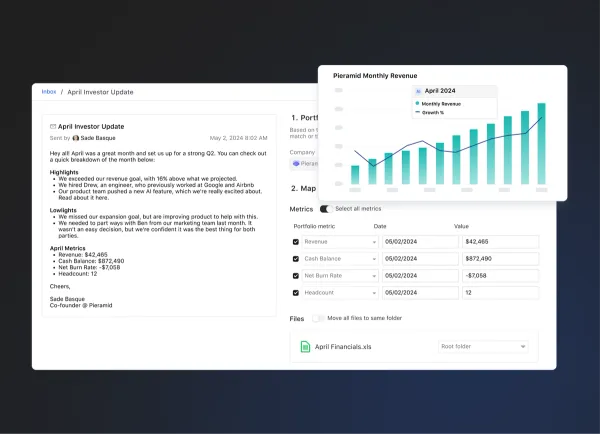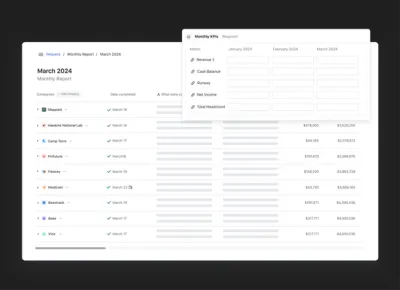
VC Fund Performance Metrics 101 (and why they matter to LPs)

Venture Capital investors expect their portfolio company founders to be on top of their key financial metrics at all times. Why? Because it fosters confidence in investors when CEOs demonstrate they’re making data-informed decisions about the way their company is operating.
On the flip side, Venture Capital investors should be just as familiar with their own key performance indicators, aka fund metrics. A great way to impress Limited Partners is to demonstrate you have a deep understanding of both how fund metrics are calculated and why they matter to LPs.
In this article we define the key fund metrics every fund manager should always have at the ready and why they are important.
Multiple on Invested Capital (MOIC)
Definition: MOIC is considered the most common fund metric and is used to determine the value of a fund relative to the cost of its investments. In other words, it measures the amount gained on investments. Anything above a 1.0x is considered profitable. MOIC can be an effective way for LPs to compare the performance of the Venture Capital funds they’ve invested in; however, because it includes both unrealized and realized value, it’s not a true indicator of fund performance.
How It’s calculated:
(Unrealized Value + Realized Value) / Total Invested into the Fund
Why it matters to LPs: MOIC is a straightforward metric that measures how much value the fund as a whole is generating over time.
Related resource: Multiple on Invested Capital (MOIC): What It Is and How to Calculate It
Gross Total Value to Paid-in-Capital (TVPI)
Definition: TVPI demonstrates the overall performance of the fund relative to the total amount of capital paid into the fund to date. A TVPI of 1.5x means for every $1 an LP invested, they’re projected to get $1.5 in value back as a return.
How It’s calculated:
(Total Distributions + Residual Value) / Paid-in-capital = TVPI
OR
DPI + RVPI = TVPI
Why it matters to LPs: This is an important metric for LPs because it demonstrates how much money they’ve (individually) received back to date from the fund as well as how much they are predicted to receive (residual value) after all the all assets (companies) have been sold as it relates to their (individual) investment. LPs like to use TVPI because it’s straightforward to calculate and hard to manipulate.
LPs will be ok with TVPI’s lower than 1 for the first few years but then will start expecting to see an TVPI of 1 or higher as your company’s hopefully get marked up in value and you start distributing fund back to LPs.
Related Resource: TVPI for VC — definition and why it matters
Residual Value per Paid-in-Capital (RVPI)
Definition: RVPI is the ratio of the current value of all remaining investments (after the GPs have done their mark up and mark downs) within a fund compared to the total contributions of LP’s to date. It essentially tells LPs the value of companies that hasn’t been returned (yet!) compared to how much has been invested.
How It’s calculated:
Residual Value / Paid in Capital = RVPI
Why it matters to LPs:
LPs want to know the likely upside of investments that haven’t been realized yet. For this reason, LPs are likely comparing your RVPI against funds with the same vintage.
Distributions per Paid-in-Capital (DPI)
Definition: DPI is the ratio of money distributed (returned) to LP’s by the fund, relative to the amount of capital LP’s have given to the fund.
How It’s Calculated:
Distributions / Paid-in-capital = DPI
Why it matters to LPs: LPs will be comparing your RVPI and DPI numbers to understand where your portfolio is at in terms of maturity. A high DPI means you’re portfolio is more mature because you’ve already been able to start making distributions back to your LPs as opposed to just have a high residual (potential payout) value.
Internal Rate of Return (IRR)
Definition: IRR is the second runner-up for the most common fund metric. IRR shows the annualized percent return that’s realized (or has the potential to be realized) over the life of an investment or fund. A high IRR means the investment is performing well (or is expected to perform well). If you’re a seed stage investor you should be targeting at least a 30% IRR according to Industry Ventures.
How It’s Calculated:
Because of the advanced nature of this formula it’s best to use an excel based calculator to calculate IRR or a platform like Visible.vc which automatically calculates IRR for you.

Related Resource –> What is Internal Rate of Return (IRR) for VCs
Why it matters to LPs: IRR gives LPs a way to measure the performance (or predicted performance) of their investments before other profitability metrics are available. This metric, unlike the others listed above, takes into account the time value of money, which gives LPs another perspective to evaluate your fund performance and compare it to other asset classes.
Check out the week from Revere VC below to get a better understanding of when each fund metric is relevant.
Venture fund metrics can get confusing.
MOIC, TVPI, DPI, IRR … ????
Beyond formulas, we teach our analysts about when to use them ⬇️
Fund still deploying? MOIC.
Investment window closed? TVPI.
Fund starts harvesting? DPI.
Historical performance when fund is complete? IRR.
— Revere VC (@Revere_VC) February 17, 2023
Tracking and Visualizing Fund Metrics in Visible
It’s important to make sure you understand not only how to calculate your key fund metrics but also why they matter to LPs; this way you can add an insightful narrative about your fund performance in your LP Updates.
Visible equips investors with automatically calculated fund metrics and gives GPs the tools they need to visualize their fund data in flexible dashboards. Dashboards can be shared via email, link, and through your LP Updates.
Visible supports the tracking and visualizing of all the key fund metrics including:
- MOIC
- TVPI
- RVPI
- DPI
- IRR
- and more.

Visible lets investors track and visualize over 30+ investment metrics in custom dashboards.
Over 400+ Venture Capital investors are using Visible to streamline their portfolio monitoring and reporting. Learn more.



